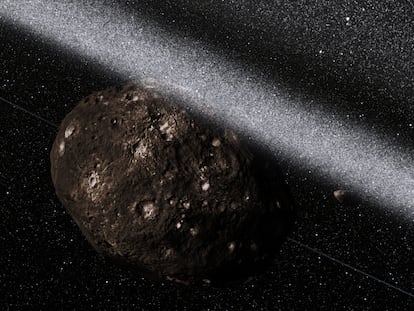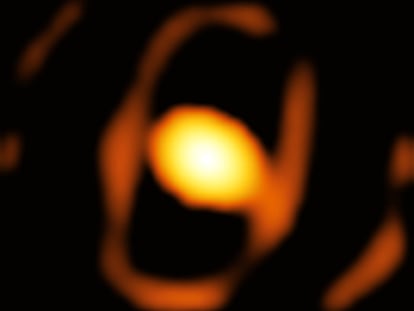Industrial mega-project in Chile threatens one of the most important astronomical observatories in the world
The scientific community is warning about a 3,000-hectare power plant that is jeopardizing the darkness of the skies over the Cerro Paranal telescopes in the Atacama Desert
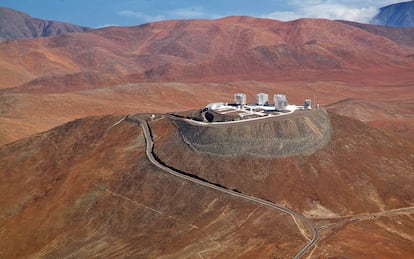
Astronomer María Teresa Ruiz’s eyes are failing day after day due to a progressive disease that affects her vision. Although she can no longer conduct research at 78 years of age, she cannot conceive of the unexpected threat that now faces the Paranal Observatory, in the middle of the Atacama Desert, which she visited so many times throughout her professional career. Ruiz was the first to issue a warning in a letter to the newspaper El Mercurio titled Natural heritage in danger, in which she accuses the company AES Andes — a subsidiary of the American electricity company AES Corporation — of planning an industrial complex of more than 3,000 hectares five just seven miles from the observatory’s telescopes. It is an electric power generation plant that would operate from wind and photovoltaic sources to produce ammonia and green hydrogen. The dark skies of the desert would be ruined during the construction of the complex and the subsequent industrial activity, which is slated to start in 2032.
The red earth, dry climate and lack of rain make this area of the Antofagasta region a natural laboratory for astronomical observation, as it has one of the darkest and clearest skies in the world. The industrial activities that would arise during the construction phase and subsequent operation would produce serious consequences that would affect scientific work in an area equivalent to the size of a small city. “Destroying this treasure [the observatory] is a real atrocity, not only for Chile, but for all of humanity,” says Ruiz, the first woman in the country to receive the National Prize for Exact Sciences (1997).
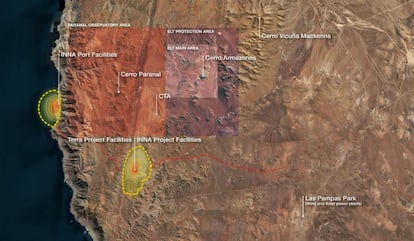
Since the Chilean State and the European Southern Observatory (ESO) signed a collaboration agreement in 1963, investment in science has been exponential. Opened in 1999, the Paranal Observatory has been the protagonist of countless discoveries in the field of astronomy, such as the first image of an exoplanet and the confirmation of the accelerated expansion of the universe. The most sophisticated optical observatory to date is located there, the Very Large Telescope (VLT), which has operated for more than 25 years. And within this decade, the titanic Extremely Large Telescope (ELT) and the CTA-South will be added just 12 miles away from Cerro Armazones, turning the ESO observatory into an unprecedented astronomical hub, sponsored by 16 European countries. Now, the organization has publicly denounced the threat posed by the AES project.
AES Andes’ first contacts with ESO date back to 2019 and another small project called Parque Terra Energía Renovable, which was approved in 2023 and is located very close to where the so-called INNA project is planned, which includes an estimated investment of $10 billion. They did not hear anything from the company again until August 2024. “We found out about the new project when they made a public presentation in Taltal. Nobody had told us anything, and we had to approach them,” says Itziar de Gregorio, ESO representative in Chile.
“The fact that the AES Andes industrial mega-project is so close to Paranal represents a critical risk for the most pristine night skies on the planet,” ESO Director General Xavier Barcons said in a statement. “Dust emissions during construction, increased atmospheric turbulence and, especially, light pollution, will have an irreparable impact on astronomical observation capabilities, which until now have attracted multi-million euro investments from the governments of ESO Member States.”
The sky would exceed brightness threshold
The company provided ESO with information on the potential impact of light pollution, and the scientists developed prediction models through the Illumina program. The results confirm that INNA “presents a substantial risk of increasing sky brightness by a factor of at least 3, particularly if the project is expanded to a scale of several gigawatts.” This means that within the classification of the scale that measures from level 1 (dark sky) to 9 (urban sky), Paranal would lower its astronomical quality from “excellent dark sky” to “rural sky,” at best. ESO claims that other sources of light pollution, such as lights inside buildings, walls, and metal structures, have not been considered either.
The reason Chile hosts ESO observatories such as La Silla, Paranal, and Chajnantor is because of the combination of geographical and climatic conditions found in the world’s driest desert. Paranal and Armazones are home to unique heritage sites, and the project’s brightness would raise the “1% threshold of excellence,” potentially impacting astronomical observations at the darkest site among the 28 astronomical observatories currently in existence, according to a 2023 study in the journal Monthly Notices of the Royal Astronomical Society.
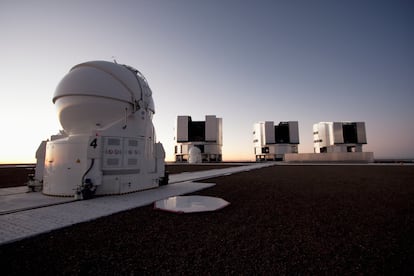
The lead author of the analysis, Fabio Folchi, has also been concerned about what is happening since he read the ESO note. “The only way is not to go ahead with the project. There is no such thing as friendly light pollution,” he says bluntly. INNA is also considering building an industrial port on the coast to ship the final products generated abroad, which would also contribute to increasing the brightness of the sky by up to 20%, according to an analysis carried out by Fastcheck.cl.
The lighting regulations that govern the country are quite lax. Pedro Sanhueza, a former head of the Office for the Protection of Sky Quality in Northern Chile for 20 years, knows this well because he collaborated in its development. “In the construction phase of all these industrial projects there is usually a lot of light, more than there is in the operation phase. As it is something temporary that will last a few months or years, companies tend not to process any permits and this is due to lack of knowledge,” he explains.
The essential thing, according to Sanhueza, is that a strategic environmental assessment must be carried out because the norm establishes conditions for lighting equipment, but does not place obstacles on the amount of lighting equipment that can be installed. “With just one certificate, you could install thousands of lights near Paranal and you would be complying with the legislation,” he points out.
The government has called an inter-ministerial roundtable discussion with representatives from the Ministries of Science, Technology and Innovation, Energy, Economy, and Foreign Affairs in order to reach an intermediate position and find solutions. The Undersecretary of Science, Cristián Cuevas, explains to EL PAÍS that it is the Chilean Environmental Assessment System that has to examine this type of project. “It is possible to harmonize the development of an agenda for diversifying the energy matrix, while at the same time safeguarding areas of scientific interest, particularly astronomy, with skies that allow us to concentrate 60% of the world’s astronomical observation,” he says.
On the other hand, a spokesperson for the Chilean Ministry of Energy told this newspaper that it is not making any statements in this regard. However, it reiterated that the ministry is respectful of the institutional process. In a similar response, the Regional Directorate of Evaluation Services of Antofagasta also indicated that it cannot comment “on projects that are under environmental evaluation.”
AES Andes confirmed to EL PAÍS that it is not giving interviews, but the company is willing to “collaborate with all interested parties in the environmental processing process.”

Sign up for our weekly newsletter to get more English-language news coverage from EL PAÍS USA Edition
Tu suscripción se está usando en otro dispositivo
¿Quieres añadir otro usuario a tu suscripción?
Si continúas leyendo en este dispositivo, no se podrá leer en el otro.
FlechaTu suscripción se está usando en otro dispositivo y solo puedes acceder a EL PAÍS desde un dispositivo a la vez.
Si quieres compartir tu cuenta, cambia tu suscripción a la modalidad Premium, así podrás añadir otro usuario. Cada uno accederá con su propia cuenta de email, lo que os permitirá personalizar vuestra experiencia en EL PAÍS.
¿Tienes una suscripción de empresa? Accede aquí para contratar más cuentas.
En el caso de no saber quién está usando tu cuenta, te recomendamos cambiar tu contraseña aquí.
Si decides continuar compartiendo tu cuenta, este mensaje se mostrará en tu dispositivo y en el de la otra persona que está usando tu cuenta de forma indefinida, afectando a tu experiencia de lectura. Puedes consultar aquí los términos y condiciones de la suscripción digital.
More information
Archived In
Últimas noticias
The impact of Ecuador’s mega-prison: A polluted river, cleared forests and military checkpoints
Corinne Low: ‘I’m more concerned about the female happiness gap than the gender wage gap’
Trump traveled on Epstein’s plane ‘many more times’ than previously thought, according to new documents
Venezuelan exiles in Madrid scramble to salvage Christmas plans after flight cancellations
Most viewed
- The low-cost creative revolution: How technology is making art accessible to everyone
- Christian Louboutin: ‘Young people don’t want to be like their parents. And if their parents wear sneakers, they’re going to look for something else’
- All the effects of gentrification in one corner of Mexico’s Colonia Roma
- Liset Menéndez de la Prida, neuroscientist: ‘It’s not normal to constantly seek pleasure; it’s important to be bored, to be calm’
- Christmas loses its festive spirit: ICE fears cast shadow over religious celebrations

